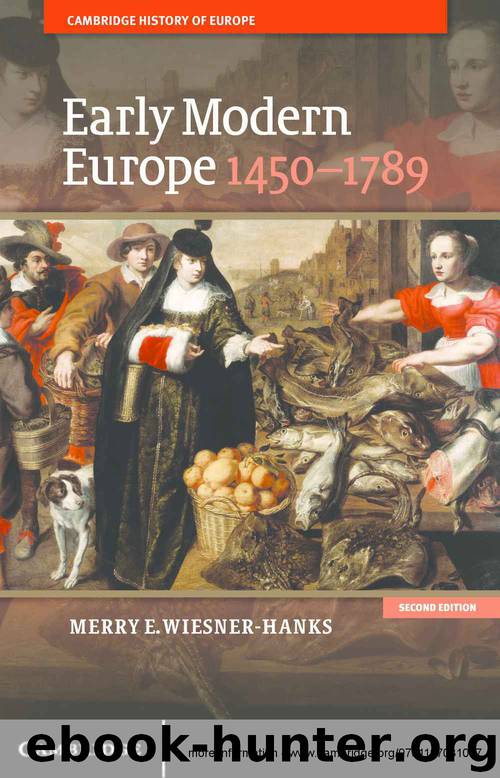Early Modern Europe, 1450-1789 (Cambridge History of Europe) by Merry E. Wiesner-Hanks

Author:Merry E. Wiesner-Hanks [Wiesner-Hanks, Merry E.]
Language: eng
Format: azw3
Publisher: Cambridge University Press
Published: 2013-02-28T05:00:00+00:00
Notes
1 R. H. Major, ed. and trans., Select Letters of Christopher Columbus (London: Hakluyt Society, 1847), pp. 1, 4.
2 Ibid., p. 15.
3 Martin Waldseemüller, Introduction to Cosmography (1507), trans. in George Kish, A Source Book in Geography (Cambridge, MA: Harvard University Press, 1978), p. 319.
Part II
8 Individuals in society, 1600–1789
The title page of Thomas Hobbes’s Leviathan (1651), with an engraving by the French artist Abraham Bosse. The top half shows a huge crowned king, with a sword in one hand and a bishop’s staff in the other, rising above a countryside with villages, a walled city, and a church, while the bottom shows various symbols or elements of sacred and secular power.
THE title page of Leviathan, a political treatise arguing the need for an authoritarian, unchallengeable ruler, written by the English philosopher Thomas Hobbes (1588–1679), is one of the most famous images of society from the seventeenth century. Though the head of the king is that of a single individual, his body is made up of the tiny bodies of many men. In Leviathan, Hobbes argues that the true basis of government is not a divine right conferred by God, but the agreement – the word he uses is “contract” – of the residents of a state to form a society with an absolute ruler at its head who has both civil and ecclesiastical authority. Once they have done this – and it does not have to be in historical memory – they have no right to rebel; if they do not do this, they will live in a pre-political state of nature driven by fear and passion, a life that Hobbes describes as “solitary, poor, nasty, brutish, and short” (Leviathan, ch. 13). The title-page engraving illustrates this theory; the men, most of them dressed as gentlemen but a few as artisans, peasants, and clergy, seem to be in the process of fitting themselves into the body of the ruler, literally incorporating (a word that comes from the Latin word for body, corpus) themselves into his form.
Using the body as a metaphor for society or the state did not originate or end with Hobbes; many of the words we still regularly use to discuss groups that act as units, such as corporate or corporation or Marine Corps, have their origin in this imagery of a body. This metaphor was employed to support many different and sometimes contradictory ideas in the early modern period, however. In Bosse’s engraving and Hobbes’s treatise, it is individuals who incorporate themselves into the ruler, making a contract that creates “an Artificiall Man.” Other writers and illustrators saw the body politic as created by God, rather than by a human contract, and as made up of different social groups rather than individuals. The ruler was always the head, but the eyes and ears were the king’s advisors or the clergy, the hands knights, the thighs merchants, the feet peasants, the toes servants, and so on. The body was a hierarchy, but one in which each part was dependent on the others.
Download
This site does not store any files on its server. We only index and link to content provided by other sites. Please contact the content providers to delete copyright contents if any and email us, we'll remove relevant links or contents immediately.
| Africa | Americas |
| Arctic & Antarctica | Asia |
| Australia & Oceania | Europe |
| Middle East | Russia |
| United States | World |
| Ancient Civilizations | Military |
| Historical Study & Educational Resources |
Room 212 by Kate Stewart(4741)
The Crown by Robert Lacey(4575)
Endurance: Shackleton's Incredible Voyage by Alfred Lansing(4508)
The Iron Duke by The Iron Duke(4125)
The Rape of Nanking by Iris Chang(4024)
Killing England by Bill O'Reilly(3899)
Joan of Arc by Mary Gordon(3786)
Say Nothing by Patrick Radden Keefe(3729)
I'll Give You the Sun by Jandy Nelson(3274)
Shadow of Night by Deborah Harkness(3177)
Hitler's Monsters by Eric Kurlander(3165)
Mary, Queen of Scots, and the Murder of Lord Darnley by Alison Weir(3069)
Blood and Sand by Alex Von Tunzelmann(3060)
Darkest Hour by Anthony McCarten(3019)
Margaret Thatcher: The Autobiography by Thatcher Margaret(2972)
Eleanor & Park by Rainbow Rowell(2944)
Red Famine: Stalin's War on Ukraine by Anne Applebaum(2816)
Book of Life by Deborah Harkness(2721)
The One Memory of Flora Banks by Emily Barr(2686)
